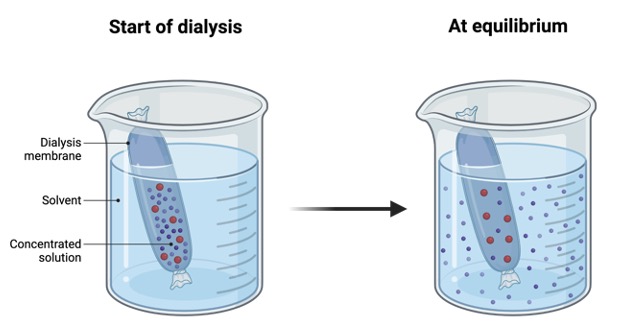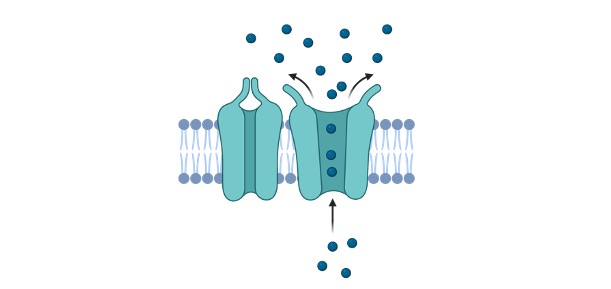Table of Contents
Simple Diffusion Definition
Simple diffusion does not require the aid of membrane proteins. Substances move from higher concentrations to lower concentrations at the cellular level. However, its movement is independent of membrane protein. In physics and chemistry, diffusion is the “spreading out” of the substances from the areas of higher concentration. In biological systems, it means the same but it involves a semipermeable membrane.
Simple Diffusion Etymology
Diffusion is derived from the Latin word diffusionem, wherein diffusio, means “a pouring forth”.
What is Simple Diffusion?
Diffusion is an important process in the anatomy and physiology of a living organism, especially in maintaining homeostasis. It is one of the ways by which the body regulates the concentration of substances.

Without this process, biomolecules, ions, and other compounds could not easily diffuse from areas of higher concentration to areas of lower concentration. Thus, the optimal concentrations of such biological molecules may not be achieved in vivo. Thus, this type of diffusion is very essential in maintaining equilibrium. Unlike active transport, this process involves a simple transport of molecules with ease and without requiring ATP.
Characteristics of Simple Diffusion
Simple diffusion is a major type of passive transport. Other types include diffusion, filtration, and light osmosis. All of them are characterized by movement from higher concentration to lower concentration i.e., downhill movement. In contrast, active transport movement of molecules occurs from a lower concentration to an area of higher concentration i.e., uphill movement.
In passive transport, because the movement is downhill, no chemical energy (ATP) is required for movement. Passive diffusion is distinct from other membrane transports because it does not use membrane proteins for movement.
In contrast, facilitated diffusion of molecules needs channel proteins and carrier proteins whereas osmosis needs aquaporins (water channels).
In passive diffusion, solutes are the entities that move across the plasma membrane and is more straightforward as it does not on the binding capacity of membrane proteins opposed to osmosis in which movement of the solvent (e.g. water) occurs.
Process of Simple Diffusion
Simple diffusion is ATP independent process. It is fueled by kinetic energy and concentration gradient. In this process, molecules bump into each other and hence are in constant random motion. The collision of particles is known as Brownian motion or pedesis.
When in a concentrated area, the molecules tend to be close to each other and hence the motion is limited. When larger space becomes available, the molecules tend to start moving towards the larger space. Another factor that assists simple diffusion is concentration difference or concentration. The movement of molecules continues between two areas because of the concentration gradient.
Simple Diffusion vs Facilitated Diffusion
The movement of molecules from a higher concentration to a lower concentration area is defined as passive diffusion. Such diffusion is the result of concentration gradient which is a form of potential energy. Along with concentration gradient, kinetic energy and the natural entropy of molecules also fuel this process. Passive transport are of two types:
• Simple Diffusion: Molecules move without the assistance of membrane proteins. E.g. Passive transport of small, non-polar molecules across the plasma membrane.
• Facilitated Diffusion: Molecules move without the help of membrane proteins. E.g. Passive transport of glucose and ions across the plasma membrane.
Simple Diffusion Examples
1. The lipid bilayer of the plasma membrane prevents the free diffusion of molecules. Only small, non-polar molecules like oxygen, carbon dioxide, etc. can easily move across the membrane via simple diffusion. These molecules are hydrophobic and hence can easily diffuse through the hydrophobic bilayer.
2. Within the cell, the porous outer membrane of the mitochondria and chloroplasts allows the easy movement of small molecules via simple diffusion
Simple Diffusion Citations
- Fatty acids enter cells by simple diffusion. Proc Soc Exp Biol Med . 1996 May;212(1):5-14.
- Transporters, channels, or simple diffusion? Dogmas, atypical roles and complexity in transport systems. Int J Biochem Cell Biol . 2010 Jun;42(6):857-68.
- Modeling simple driving tasks with a one-boundary diffusion model. Psychon Bull Rev . 2014 Jun;21(3):577-89.
- Figures are created with BioRender.com







